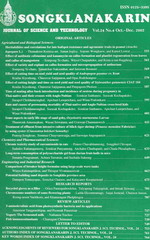ThaiScience
ThaiScience
SONGKLANAKARIN JOURNAL OF SCIENCE & TECHNOLOGY
Volume 42, No. 01, Month JANUARY, Year 2020, Pages 139 - 145
Installation of shelters on growth and survival of blue swimming crab (portunus pelagicus) for development of its culture
Vutthichai Oniam, Wara Taparhudee, Ruangvit Yoonpundh
Abstract Download PDF
The objectives of this study were to conduct experiments involving the rearing of the blue swimming crab Portunus pelagicus with four different types of shelters in concrete tanks: 1) 90° bent plastic plates; 2) concrete blocks; 3) PVC pipes; and 4) stems of coconut leaves. We aimed to find which methods promote growth and improve the survival of the crabs using the shelters. The results showed that the type of shelter affected the survival rate of the crabs, while the presence of these shelters in the tanks did not have any significant effect on its growth. The survival rates (mean±SD) of the crabs reared in the tanks with the stems of coconut leaves (82.2±7.7%) and 90° bent plastic plates (80.0±6.7%) were significantly higher than those using PVC pipes (66.7±6.7%) and concrete blocks (62.2±3.8%) as shelters. The differences of the effects of these four types of shelters on the survival of the crabs seem to reflect the available space provided by them to escape cannibalism. The rearing experiments of the crabs with different densities of 90° bent plastic plates as shelters (0, 1, 3, and 5 shelters/m2) showed a significant increases in the survival rates of crabs reared for 30 to 60 days (5 shelters/m2 71.1±3.8%, 3 shelters/m2 77.8±7.7%, 1 shelter/m2 62.2±3.8%, no shelter 48.9±3.8%), but the effect of the shelter on the improvement of the survival rate was less clear in the crabs reared for 60 to 90 days.
Keywords
Portunus pelagicus, cannibalism, shelterSONGKLANAKARIN JOURNAL OF SCIENCE & TECHNOLOGY
Published by : Prince of Songkla University
Contributions welcome at : http://rdo.psu.ac.th
